On May 6, Zach, Jennifer, Jennifer’s dad Al, and his partner Gwen left on a 3-day drive to Arkansas, where we planned to meet up with Zach’s mom Virginia and cousin Donna (who drove out from Georgia), for a 5-day canoeing and camping trip on the lower section of the Buffalo National River, between Grinder’s Ferry and the White River confluence.
The first part of the trip went fine: we had a pleasant drive out there, with Zach managing to visit Nebraska for the first time, Jennifer managing to visit Kansas for the first time (we’re both down to 4 more states!), and a side trip to Custer State Park in the Black Hills of South Dakota (where we saw a lot of wildlife).
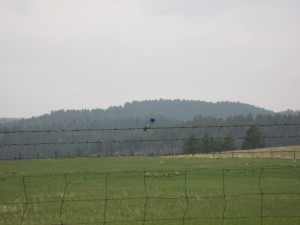
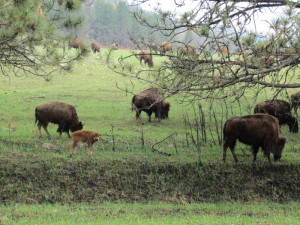
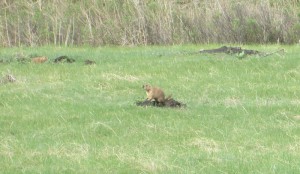

We arrived at Dirst Canoe Rental and Cabins on Sunday the 8th of May, where we had reserved a cabin for the night and 3 canoes for the next 5 days. Donna and Virginia showed up a few hours later; we got up Monday morning and started down the river. There was a forecast of some rain for the first day, but it didn’t look too bad, so we started out on the canoes, enjoying the amazingly beautiful scenery and having a pleasant float. Zach and Jennifer were in one boat; Al and Gwen in one; Virginia and Donna in the third.
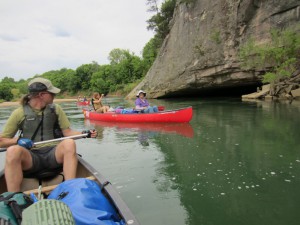
We got some rain in the early afternoon, but it was pleasant and warm, and we didn’t mind too much. Then things started to go a bit awry: Donna and Virginia hit a rock, and Virginia ended up in the water, while Donna stayed in the canoe but lost her paddle. We got through that OK — Jennifer threw a rescue rope to Donna and pulled her to shore, while Zach helped Virginia get out of the shallow water she’d made it to (everyone was wearing life jackets). Then Jennifer and Zach went across the river and rescued the lost paddle, and we traded people around (Virginia with Zach and Donna with Jennifer), and continued downstream.
About an hour later, Virginia was getting pretty cold (she hadn’t changed clothes after her spill), and it was getting late in the afternoon anyway, so we stopped on a nice looking gravel bar, and set up camp about 5 feet above the water line. We’d been advised the water could rise about a foot if it rained hard, so we thought that was pretty good. We tied our boats to a tree down below our camp, and brought the paddles up to near our tents. It started raining harder, so we scurried for our tents for a while, coming out later between squalls to cook dinner. There was some thunder and lightning, and several episodes of strong rain, but we weren’t too worried.
Then about 2 AM, Virginia woke up to pee, noticed that the river had risen nearly to our tents, and woke everyone up. We were all (of course) a bit dazed, but quickly came fully awake, and started packing up our stuff and moving it to higher ground. We also all put on our life jackets, just in case.

But we had a problem: our boats were below us! They were tied to a tree, and we could see that at least one of them was still there, but it didn’t seem too secure (the boats were floating by then), and there was moving water between us and our boats. So, Zach and I got most of our stuff to higher ground, and with a rope that the others managed from shore, walked and swam to where the boats were, tied them to the rope, and got towed back (though considerable current by this time) to the shore. But we hadn’t taken down our tent before we went swimming for the boats, and the tent was swept away by the river, which had by then risen to above where we had originally camped. However, we felt like we’d done the right thing — we needed to boats more than the tent, and it wasn’t a brand new tent or very expensive.
It was kind of a long night… We had to move up to higher ground a few more times through the night and morning, as the water kept rising — nearly 8 feet above what it had been when we went to sleep, in total! We built small cairns on the shore to mark where the water was, and just basically sat around and hoped it would go down… at least by 2 AM we could see stars, so we had some hope that it wouldn’t keep rising forever.
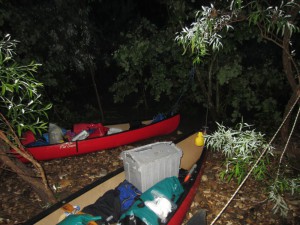
Tuesday, when it got light, we looked at the flood-stage river, and (hoping that the water wouldn’t rise to the point of totally covering the decreasing real estate we were sitting on) decided we should stay put. The weather stayed clear, so we were able to dry out our stuff, and sometime mid-day, the water finally started to go down again. Zach wandered around the newly revealed area and found a lot of things that had gotten lost in the night, but not our tent… we also permanently lost a camp lantern that was in the tent, one of Zach’s paddling gloves, and Zach’s waterproof camera (which wasn’t all that great of a camera, but had provided a few nice pictures for our past blog posts about snorkeling). I think everyone else found everything they had misplaced.
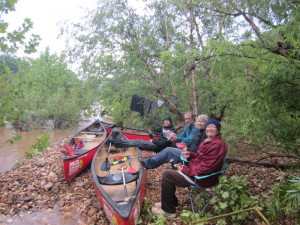
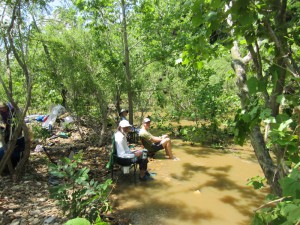
Al, Gwen, Zach, and I all slept out that night by the canoes under the stars, but I don’t think we got much sleep, although the water continued to go down all night. On Wednesday morning the river was not quite as low as when we had arrived, but it looked more like a river than a flood, so we were able to pack everything up and float 12 miles down the river to a take-out where there were phones. This time, Donna went with Al, Virginia with Zach, and Jennifer with Gwen. When we got to Buffalo Point, we phoned the very relieved Dirst outfitters, who came down to where we were (a mile down the road from their place), and picked us up. It turned out that on Tuesday, Doyle at Dirst’s had been phoning the park service, who were not helpful at all, and he had also gone upriver a ways in his boat to try to find us — but his boat motor gave out before he got up to where we were. Luckily, he made it back safely, and we were OK anyway.
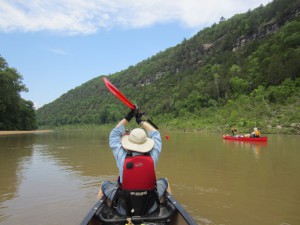
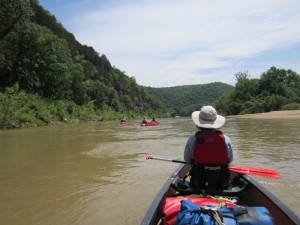
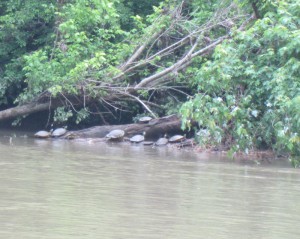
We stayed in the cabin that night, and Thursday, Jennifer, Al, and Gwen did a day float down the next section of the river, while Virginia, Donna, and Zach did some hiking in the area. We met up at Rush, our take out point, which had been a small zinc mining town in earlier times.
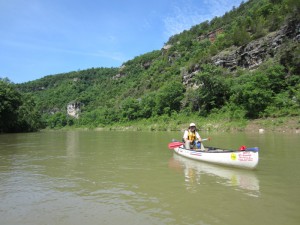
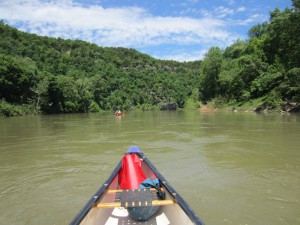
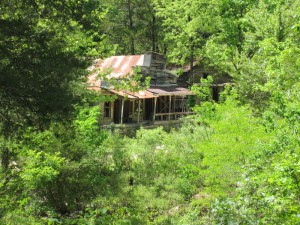
Thursday afternoon, the Georgia and Washington contingents of our group parted ways. Zach, Jennifer, Al, and Gwen were going to drive home, but as we were heading out, Zach had the idea that we could float another section of the river with our remaining day, so we headed up to Ponca (upriver from the section where we had been), and did that section on Friday. This was more technical whitewater than we had wanted to do with a load of camping gear, but it was very fun for a day float (it’s also the most popular section of the river, and very beautiful).
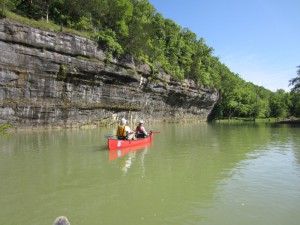
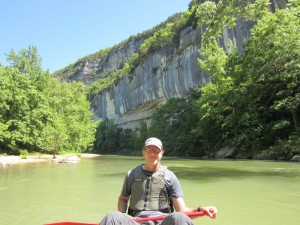
After our float, on Friday afternoon we drove up to Moberly, Missouri and stopped to visit Jennifer’s second-cousin Kay Huckel Cook for the night at her farmhouse. We got to meet her 3 cats, 5 chickens, and various catfish and koi in her pond.
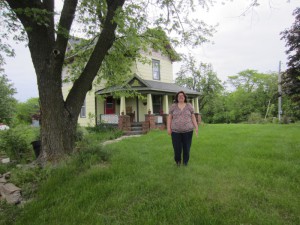
Saturday, Sunday, and Monday, we drove back home, with stops at the Sierra Trading Post store in Cheyenne (where Zach and I found a great deal on a nicer tent than the one we’d lost), a place called Vedauwoo near Laramie Wyoming (where we looked at some beautiful rock formations in the fog), Little Bighorn National Monument, and Lewis and Clark Caverns in Montana. We arrived home on Monday the 16th in the afternoon.

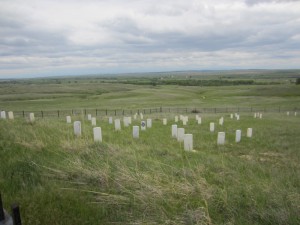

So… All’s well that ends well — it could have turned out a lot worse (no one got hurt, not much gear was lost, and we got ourselves out safely). And really, at least the 4 of us who drove together all thought it had been a good trip overall. We did learn a few lessons about the Buffalo River and river trips in general:
- Get better information before you go, and don’t accept that information doesn’t seem to be available. The problem was that the web sites (including the National Park site), maps, and books that we found before our trip really didn’t say much about the Buffalo River. We had no idea until after we were back at Dirst’s safely that the water even could rise that much (or more!) — we had been advised to make sure we were camped at least 4 feet above the water line and it seemed like enough. It wasn’t. After we got back, Gwen located a USGS web site that shows water height data for this part of the Buffalo River (that’s how we made the graph above). Looking at the historical data on that site, I found that an even more drastic river level rise happened last year in early May, where the river rose from 5 feet to 15 feet in a twelve-hour period, and then went up to 30 feet in the next twelve hours. We had no idea about this being possible and/or common before our trip.
- Don’t trust the weather forecast. The forecast had been for at most about 1/2 inch of rain. It turned out to be 3-4 inches instead, which made the water rise way more than we were expecting. Of course, we also didn’t really have any way of knowing that that much rain had fallen in the river’s watershed while we were on the river. On the other hand, much of that rain fell after it was dark and we had already set up camp, when there wasn’t much we could safely do about it anyway (you don’t want to canoe in the dark).
- Put your canoes and paddles above where your tents are (Zach was advised about that, but no one else heard it), and tie them to something sturdy. You need your canoe. Thank goodness we had tied the boats and we hadn’t left our paddles in the boats — Jennifer was worried about them during the squalls, and got them to higher ground before we went to bed — they would have been gone if we had just left them sitting under the boats.
- Make sure there is a route available to much higher ground, especially if the weather is questionable. We very nearly ran out of land where we were, as the gravel bar we were on turned into an island that was only a couple of very small inches above the highest level the water reached. And even without the island factor, the river bank on the other side of the flood channel was also very steep — we would not have been able to climb up the bank very easily to get to higher ground.
- Set a watch when you camp in questionable weather. Since we knew it was raining, we should have had someone checking the water level systematically throughout the night, or taken turns staying awake.
- When someone goes for an unscheduled swim, stop and make sure they change into dry clothes before continuing — they may not be aware of how dangerously cold they are getting or will soon get. As a corollary, make sure that each person knows where their dry clothes are, so they can be found easily and quickly.
- Keep your life jacket (PFD) near where you are sleeping, and secured so that it won’t blow or float away. We lost access to one of the life jackets while the flood waters were high — it was hanging on a nearby tree to dry, but that tree ended up being in the flood channel. Luckily we had an extra flotation cushion along, and we also got the life jacket back when the waters receded and before we needed to float anywhere.
My gosh you were LUCKY!!! —Angels watching over you! What an experience of doing WELL in the rising water and rain and coming through smelling like…roses!!!! (This metaphorically!!) :-)
All I can say is Wow! I looked at the weather map the weekend before and wondered if you would get on the river at all given what I saw. Apparently, that didn’t resonate with you guys on the ground. The phone conversations after your ordeal were truly frightening; I liked Jennifer’s putting things in some perspective; cheap tent; “things started to go a bit awry!” Indeed, from Virginia’s report the night while the river rose was something else again. I believe she suffered later from a form of PTSD, perhaps due to exposure and then finding numerous ticks on her body. I figured going with you guys was a no brainer no matter what might happen and it turned out that was true. I trust Al had several beers to tide him over!
Meanwhile I was in the hospital after an 8-hour surgery to remove a verrucous carcinoma tumor in my lower right jaw. It was removed successfully; no radiation followup is needed. My right fibula along with its vascular system was “donated” to my mandible reconstruction; the donor site is more problematic than the jaw at the moment. Meanwhile I got out of the rehab hospital a week early (three instead of four weeks), but continue to be on liquid food until cleared to go the next step. Like you guys, the surgery was a bit dicey, the immediate recovery was Hell, but I came out of it ok. The Shakespeare quote says it all!
Malcolm
Great pictures,charting,and historical data. What an adventure,and not for the faint of heart or body. Most interesting! Thanks for sharing. Hope this finds you all well. Jill